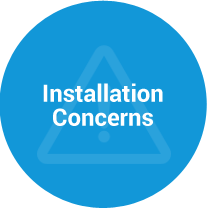Innovating Our Solutions and Our Website. As we introduce new solutions to better meet your needs, we’re also rolling out a new and improved website. Thank you for your patience during this time.
Epoxy Lining is a general term for a variety of different plastic resins used on hot and cold water supply pipes, sprinkler lines, HVAC piping, gas lines and certain drain, waste and vent piping. The National Sanitation Foundation (NSF) and U.S. Environmental Protection Agency (EPA) have certified some epoxy linings for carrying potable drinking water. Epoxy resins are generally not certified as a “structural improvement” to the existing piping system.
Click on the icons below to read more about the concerns and challenges of epoxy pipe lining.
Hazardous Materials Considerations
The EPA requires all properties built before 1978 to perform extensive testing for the presence of lead and Asbestos Containing Materials (ACMs) prior to disturbing any existing materials, which includes cutting into any wall surface. Due to the permitting process required for a repipe, when a building is of age, HAZMAT testing is always completed before the job begins. Depending on the building configuration, the scope of work for a lining project may not include drywall demolition, and as such, testing may not be completed before the job begins. However, if testing is not done prior to the start of an epoxy lining project and a blowout occurs, the project must stop until such testing can be performed. In such cases, the water supply may be interrupted for as many days as it takes for this process to occur. If, during the testing process, ACMs or lead are determined to be present over the limits set by the EPA, wall demolition must be performed by a licensed hazardous materials remediation contractor under EPA and Occupational Safety and Health Administration (OSHA) approved containment procedures. If this is not planned for in advance, significant work stoppages, increased costs and considerable disruption to residents may occur. Failure to perform the required testing leaves the building owner or Home Owners Association (HOA) board of directors and lining contractor open to significant liability and fines.
Epoxy Lining Conclusions
The overwhelming amount of risk associated with epoxy lining, coupled with observations of failed installations and their consequences, has led the authors to conclude that epoxy lining pipes within the building envelope is not a comparable alternative to pipe replacement. Before making an investment decision, it is always advisable for a community to explore all its options, including a repipe, to ensure their property is making the most informed decision possible about fixing its leaking pipes.










